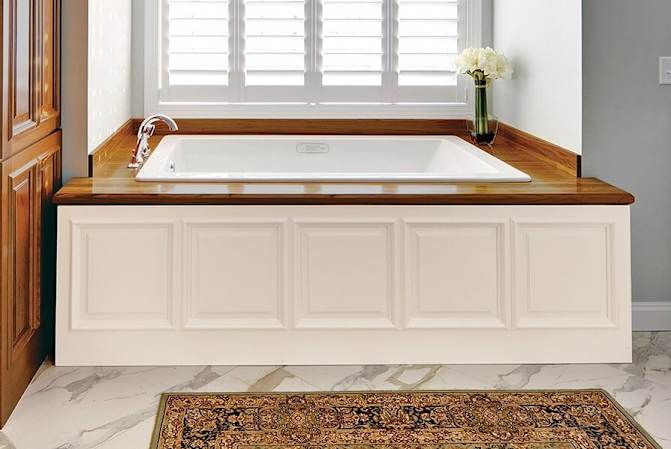
Wainscoting is a basic carpentry project that, when done right, can transform a dull room or corridor into a showpiece. Depending on the style of your home and personal preferences, a wide variety of wainscoting options is available to choose from. Some have an ornate, elaborate design, with features like hand-carved friezes and pilasters. Others have a classic, aged polish. And some are both functional and aesthetically pleasing. So if you are about to renovate your home or move into a new one but wish to add a personal touch to it, wainscoting could be just the thing you're looking for. To help you make the most of this lovely and useful feature, we've consulted our experts and found original ways to use wainscot panels. But first, let's find out what wainscoting is.
Wainscoting is a type of tongue-and-groove paneling traditionally installed in homes' working areas to protect the walls. It consists of planks, boards, and moldings covering most of your walls' lower portion. Wainscoting is typically a single, continuous panel of paneling, most often constructed from wood.
Wainscoting serves primarily as a wall protector. Whether it's the kids carrying in groceries or you kicking off your shoes in the entryway, there are a number of ways in which your home's walls could sustain damage. You can also use it to cover unsightly pipe and cable runs or to make crooked walls appear more uniform. It can be a perfect addition to your new home!
The best part about wainscoting is that it's pretty easy to install. Trust us, cleaning the home after moving in and getting everything ready before remodeling will be arduous. Once you prepare the ground first, installing wainscot panels will be a piece of cake. But before you proceed to the installation, let's go through some original ideas for wainscoting in your home.
As we mentioned, wainscoting has been a common way for homeowners to safeguard their walls against scuffs, scrapes, and other wear and tear for decades. Basically, it's a form of ornamental wall paneling with a protective function. Even though it's up to you to choose the type of wainscoting, it's common for it to match the period of the house.
While wainscoting is most commonly associated with older homes and more traditional interiors, it is also a great way to give depth and texture to more contemporary settings. In fact, it's still quite popular among homeowners. And kitchen design trends for 2022 confirm that. But let's cut to the chase – here are original ways to use wainscot panels in your home.
Walls in mudrooms or entryways are especially vulnerable to damage from backpacks, boots, and wet umbrellas. Wood wall paneling provides a beautiful finish while hiding imperfections and eyesores like cables and cabling.
Wainscoting your entryway will make it look more elegant and add character to plain walls. With some careful matching of paint or pattern, as well as the addition of color and perhaps a bookcase, you can transform a drab foyer into a warm and welcoming place.

Your living room might benefit from wainscoting, both aesthetically and functionally. When designing a living room, it's crucial to strike a balance between formality and coziness, and wood wall cladding combined with upholstery can help achieve this.
Wainscoting in the living room not only provides flair and character but also serves as a focus point. It's common practice to have gatherings of friends and family in the living room. A feature like wainscoting allows you to present a beautiful room and make it a warm and inviting place to feel at home.
Wainscoting is an excellent choice for preventing walls in hallways from being damaged, as there is less room to avoid bumping into them. Wainscoting a staircase may need more time and effort than wainscoting any other part of a home, but it is still a relatively simple DIY project. It takes a bit more effort and planning, but the end effect is a stunning addition to your stairwell.

Instead of expensive tiled walls and treated MDF that protects the plaster underneath from water damage, wainscotting made from warp-resistant wood is a great alternative. Bathrooms often have cold materials like porcelain fixtures, tiling, and tub enclosures; wood adds a cozy touch.
Wainscoting is a great way to tie the lower half of your bathroom walls and fixtures, like the tub and vanity, together. Also, you can use it if you have a standalone tub and want to prevent water damage to the walls. Wainscoting isn't limited to just one wall; it may wrap around and frame everything from built-in seating to sink cabinets.
If you want your dining room to feel cozy and inviting, wainscoting is the way to go. It's safe to assume that a formal dining room would benefit from a more traditional aesthetic treatment. Wainscoting is a great way to create a traditional look and feel and give your room some more pizzazz.
The dining area is frequently under-furnished. Furniture in a dining room often consists of a table and chairs and additional storage options, such as a bookcase or a Chinese cabinet. Because of this, it might become an unwelcoming and chilly environment. Wainscoting installation creates a textural feature, making the room feel complete and homey.
We hope that the original ways to use wainscot panels we've mentioned in this article gave you an idea of how to implement wainscoting into your home design. Of course, you can always look for inspiration and ideas online. But if you turn on your creativity a little bit, we're sure that tons of ideas on how to dress up the walls in your home and add your personal touch using wainscoting will come to your mind in no time.